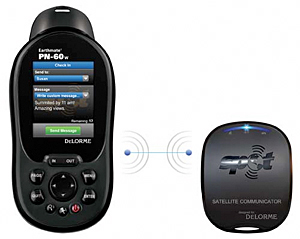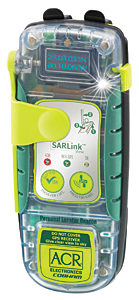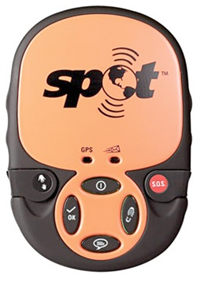Currently, there are two main locators available to the backcountry traveler: the ACR 406 series and various SPOT devices. While ACR and SPOT share some capabilities (like new, non-emergency messaging functions), the ACR and SPOT units operate under significantly different paradigms, as discussed in my SPOT gear test article.
ACR
ACR's 406MHz personal locator beacons (PLB's) use the COSPAS-SARSAT satellite system. In their current SARLink and AQUALink forms an emergency activation transmits the user's GPS-derived location through the GEOSAR (geosynchronous) and LEOSAR (low orbit) satellites.
True PLBs, like the ACR, transmit on two frequencies, 406MHz (for the satellites) and the old standby 121.5MHz for homing (the standard frequency for aircraft ELTs, for example). The 121.5 frequency can be used with Doppler location in case of failure of the unit to transmit a GPS-derived position.
ACR claims "true global coverage" for the system, though strictly speaking, this is incorrect. The regions in the immediate vicinity of the North and South Poles are only marginally covered. However, all continents and ocean regions are covered, subject to the usual limitations imposed by canyon and canopy.
Like SPOT (below), the new ACR units have added limited non-emergency messaging capability. ACR's 406Link service allows you to self test your unit to confirm it is working and send pre-programmed messages to a designated group of five contacts. Unlike SPOT, messages are sent via the COSPAS-SARSAT satellites. The 406Link service costs $39.99 annually for Basic service (self testing messages to the account owner only) or $59.99 for Plus service (self testing plus "I'm okay" pre-programmed messages sent to five contacts via text and/or e-mail).
ACR also added digital displays to two units: the SARLink View and the AquaLink View (the more buoyant marine version, in case you drop it out of your kayak mid-ocean). In an emergency, they display data, like GPS coordinates and remaining battery power, so you know the beacon is working to summon help. When sending non-emergency messages, the View units include your GPS-derived location with a link to view the location on GoogleEarth. With SARLink and AquaLink only the pre-programmed message is sent.
SPOT
SPOT has two new packages. The first is the SPOT 2 Satellite Messenger, which launched last fall. The new unit is smaller than the original by about one-third and has a higher sensitivity GPS chipset. This higher sensitivity is said to overcome many of the deficiencies due to the old chipset and antenna design when under canopy (canyon effects require a different approach that is not found in civilian GPS receivers).
The SPOT 2 retains the "911/Rescue," "OK," and basic "Help" messages, plus some added user-selectable messages. The "Help" and "911" buttons now have removable covers added to reduce accidental transmissions. SPOT uses the GlobalStar satellite phone system to transmit its location and various messages. The use of the digital service on the GlobalStar satellites means that the coverage is limited to the same areas for the most part that GlobalStar covers.
Since GlobalStar is dependent on ground stations (due to their "bent-pipe" architecture), parts of some continents (such as areas of Africa I visited while climbing Kilimanjaro), all of Antarctica, and areas beyond 80 degrees latitude (north and south, though for practical purposes, it is more like 75 degrees), along with major parts of the oceans (including Easter Island, where I will be in July) are not covered. These coverage holes do not affect most Trailspace readers, but are worth consideration if you'll be traveling to farther-flung locales.
SPOT has several messaging programs, ranging from a basic transmission to your team of five plus the 911 emergency message, to tracking and rescue insurance. The full package costs about $160 per year, automatically renewed (unless you cancel 30 days before your expiration date — there has been some discussion on Trailspace about the automatic renewal appearing on your credit card bill without notification beforehand, so mark the date on your calendar).

The forthcoming DeLorme PN-60w GPSR and SPOT Satellite Communicator combo
The second new SPOT package will consist of a DeLorme PN-60w GPSR and a SPOT Satellite Communicator. It is due out this spring. The two units will communicate wirelessly (the "w" suffix on the PN-60w) via a WiMax-like protocol, giving a several mile range. The GPSR will determine the location and will be capable of having text messages inserted to be transmitted via the SPOT/GlobalStar digital messaging system to a group of five selected individuals (or a larger group via the Share service).
The big step-up over the SPOT 2 (besides the added price of the PN-60w) is the performance of the PN-60w, which is a big improvement over the PN-40 GPSR (I have a PN-40). The two units' link capability means that, in principle, the user could leave the Communicator at the campsite in a location with a clear view of the sky, while the user goes for a day hike, sending important messages to his "team." The various subscription options have not been announced yet.
We hope to have a SPOT 2 for review in the near future, and perhaps the Delorme-SPOT combination in the late spring. However, the ACR PLB's cannot be tested in full, since that would activate a full-scale search and rescue operation.
Responsible Beacon Usage
Personally, I have reservations about the proliferation of "social networking" invading the wilderness. Texting, Twitter, Facebook, instant messaging, e-mail, and other forms of communications are rampant and increasing all around us (like it or not). It is one thing to have those capabilities in the city, another thing entirely to bring them into the backcountry. However, there is obviously a demand and a market for these functions, as evidenced by the units mentioned above.
I discussed with the locator companies the issue of responsible usage and incidents involving false alarms and "taxi calls" via various beacons. No beacon manufacturer is immune to this potential problem, along with people using their cell phones to call in a GPS-derived location. During Outdoor Retailer last month, I talked as well to guides and search-and-rescue members about this issue. I will write a more extensive discussion later, but for now, I will mention two incidents of repeated false alarms, one each for SPOT and ACR.
The SPOT incident has been mentioned before on Trailspace. Two men and their sons were hiking the Grand Canyon in September. They were ill-supplied with water. On arriving at a water source, whose quality they were uncertain of, they used their SPOT to summon the rangers. Later, they were again running low on water and summoned the rangers via their SPOT again. By the time the rangers arrived, they had moved on and found a suitable water source. A similar call resulted in the rangers forcing the four to be evacuated and to be barred from the park (the helicopter ride was not cheap!). When asked, the four said that they would not have undertaken the hike without having the SPOT in their possession.
The ACR incident is ongoing. Someone unknown is in possession of an unregistered ACR PLB in Colorado. International law requires registering PLBs before using them, a requirement apparently unknown to this owner. For the past several months, this person has set off the rescue function of his or her PLB four or five times in a weekend. Even though the unit is unregistered and the owner/user unknown, the local SAR unit is obliged to conduct a search.
The identifier allows determining the store where the unit was sold, but, since it is unregistered, not the owner. It may be that the user is unaware that he or she is setting off the rescue call, or it may be that he or she is doing so intentionally. The guide and SAR people I talked to from that area said that they are getting very tired of tying up the resources that might be needed (and on one occasion were needed) for a real emergency. The guide stated strongly that he believes that these units should not be sold to the general public.
To my mind, some fundamental education in personal responsibility and responsibility toward others is needed for users of beacons. Both SPOT and ACR stated that they are considering a public education campaign to educate buyers and potential users about the consequences of non-emergency usage.

 by Bill Straka
by Bill Straka











